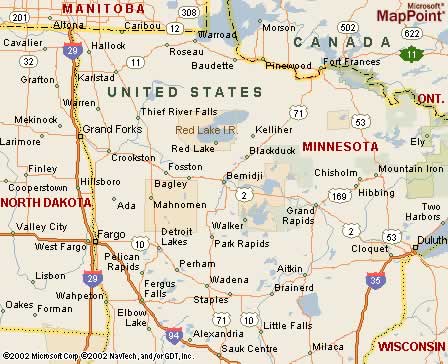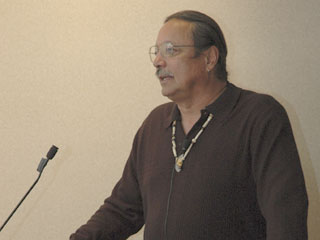 |
Canku Ota
|
 |
|
(Many Paths)
|
||
|
An Online Newsletter
Celebrating Native America
|
||
|
February 1, 2009 - Volume
7 Number 2
|
||
|
|
||
|
Gordon Van Wert Gives
Back
|
||
|
by Maria Scandale, Indian
Country Today Correspondent
|
||
|
credits: Photos courtesy
North Country Health Services
|
|
Inspirational artwork created during artist’s stroke rehabilitation
Now the four-foot carving that took shape during his stroke rehabilitation, “Medicine Bag” is an inspirational centerpiece at North Country Health Services in Bemidji, Minn. Not only does it stand for determination, but both sides of the sculpture hold symbolism that was meaningful to his healing journey. He hopes it will lift the spirits of others. Donations from tribal and health organizations funded the purchase of the artwork, which was dedicated earlier this fall at the hospital’s education center. “Through care at North Country Regional Hospital and the renewing powers of art, Gordon found a unique path to healing through his artistry. His inspiring story speaks to the compelling combination of art and medicine,” said Linnea Papke-Larson, chairperson of the NCHS Art Committee.
“My journey was difficult and long,” said Van Wert, “but I looked and found a unique path through this challenge through my art.” The exercise was a physical, emotional and spiritual journey. Where logic would say a left-handed sculptor might never work again, determination pushed Van Wert to reclaim his strength and mobility. “My art has always been my emotional therapy and it became my physical therapy,” he said. “It’s such a demanding job carving stone, so that really helped me out with my motor skills.” Oddly enough, the vibrating force of his pneumatic tools helped stimulate his damaged nerve endings, he said. “I realized I could move my toes a little bit and my fingers, so I just kept doing that. After a few weeks of working at it, I was able to raise my arm and open and close my hand.” After three months, he picked up his tools again. “It stimulated me and kept me working,” he recalls. “I got tired real quick when I first started carving again after the stroke, but I just kept at it and it just started really helping a lot.” The design of “Medicine Bag” speaks symbolically of spiritual healing processes. One side of the limestone work is carved into an eagle feather with a medicine wheel. The reverse side is a medicine bag with an eagle rising from it. “The eagle feather has been so powerful in all spiritual healing in almost every Native tribe on this continent,” Van Wert explained. “That was the symbol of the strength of the medicine. “Smoke comes from the medicine bag, representing purification, among other symbols. The medicine bag may contain roots, leaves, tobacco representing the natural medicines of the Indigenous peoples. There is strength in this kind of medicine.” When Van Wert often gives pep talks to patients in NCHS’ Acute Recovery Unit, he tells them “they can do it, too.” “You can heal yourself from within. After what happened to me, I realize that the mind is such an incredible, powerful thing for your body.”
Van Wert keeps on sculpting and sculpting keeps him going, but every day is still a challenge, he said. “With the weirdness of the nerve damage, the muscles are always trying to atrophy, so it’s an ongoing battle every day trying to keep your muscles stretched and trying to keep them moving,” he said. He is grateful to his wife, Mary, for running the business side so he is now free to just create. His first sculpture after he got out of the hospital was on a big scale. The 11-foot-tall “Our Generations” was commissioned for the Midtown Exchange in the old Sears building in South Minneapolis, Van Wert’s boyhood summer home. His dad left the family when Gordon was 10 and his mother had to raise seven children by herself. Gordon was starting to find trouble in South Minneapolis, but art got him out of it. “I got sent away to art school in New Mexico when I was 14. The judge told my mom either I was going to reform school or a boarding school. It just so happened they were recruiting students in Red Lake for that school in Santa Fe (Institute of American Indian Arts.)” After Army service, he returned to the school for a postgraduate program and really got into sculpture when he was taught by Alan Houser, known as the patriarch of Native American sculpture. Then Houser’s student Doug Hyde opened up the power of air hammers, Dremel tools and grinders. Van Wert will be teaching some classes in Red Lake to try and inspire some of the talented young people there. “I’ll tell them the stories of how I was able to make it this far after art school, because I was in some pretty bad situations when I was young.” “It was really a haphazard kind of way that I even got to be an artist,” he said. “It turned out to be a good thing.” |
 Bemidji, Minnesota map |
www.expedia.com |
|
|
||
|
|
||
| Canku Ota is a free Newsletter celebrating Native America, its traditions and accomplishments . We do not provide subscriber or visitor names to anyone. Some articles presented in Canku Ota may contain copyright material. We have received appropriate permissions for republishing any articles. Material appearing here is distributed without profit or monetary gain to those who have expressed an interest. This is in accordance with Title 17 U.S.C. Section 107. | ||
|
Canku Ota is a copyright ©
2000, 2001, 2002, 2003, 2004, 2005, 2006, 2007, 2008, 2009 of Vicki
Barry and Paul Barry.
|
||
 |
 |
|
|
The "Canku
Ota - A Newsletter Celebrating Native America" web site and
its design is the
|
||
|
Copyright ©
1999, 2000, 2001, 2002, 2003, 2004, 2005,
2006, 2007, 2008 of Paul C.
Barry.
|
||
|
All Rights Reserved.
|
||
 BEMIDJI,
Minn. – “Art is a healing thing,” said sculptor Gordon
Van Wert. Sculpting carried the 56-year-old member of the Red Lake
Band of Chippewa Indians through his tedious recovery from a paralyzing
stroke. Forty years earlier, the chance to take art classes had
whisked him off the South Minneapolis streets that were leading
to a dead end.
BEMIDJI,
Minn. – “Art is a healing thing,” said sculptor Gordon
Van Wert. Sculpting carried the 56-year-old member of the Red Lake
Band of Chippewa Indians through his tedious recovery from a paralyzing
stroke. Forty years earlier, the chance to take art classes had
whisked him off the South Minneapolis streets that were leading
to a dead end. It
was three years ago Sept. 22 that Van Wert suffered an embolic stroke
while traveling on business near Washington, D.C. Fortunately, he
was close enough to get to a Maryland hospital where emergency treatment
cleared the blood clot that had deprived oxygen to the right side
of his brain. But the stroke left his entire left side paralyzed.
The next step would be rehabilitation back home at NCHS’s Acute
Rehab Unit.
It
was three years ago Sept. 22 that Van Wert suffered an embolic stroke
while traveling on business near Washington, D.C. Fortunately, he
was close enough to get to a Maryland hospital where emergency treatment
cleared the blood clot that had deprived oxygen to the right side
of his brain. But the stroke left his entire left side paralyzed.
The next step would be rehabilitation back home at NCHS’s Acute
Rehab Unit.  In
appreciation to NCHS for their “excellent therapy” that
“helped inspire the piece,” Van Wert made the sculpture
available for $10,000, where it normally would sell for $25,000.
NCHS has committed $5,000 towards the purchase. Also making the
installation possible were The Anishinaabe Arts Initiative, a program
supported by the Region 2 Arts Council with funding from the McKnight
Foundation; Red Lake Gaming on behalf of the Red Lake Band of Chippewa
Indians; Bemidji Medical Equipment; the North Country Health Services
Auxiliary and the NCHS Art Committee.
In
appreciation to NCHS for their “excellent therapy” that
“helped inspire the piece,” Van Wert made the sculpture
available for $10,000, where it normally would sell for $25,000.
NCHS has committed $5,000 towards the purchase. Also making the
installation possible were The Anishinaabe Arts Initiative, a program
supported by the Region 2 Arts Council with funding from the McKnight
Foundation; Red Lake Gaming on behalf of the Red Lake Band of Chippewa
Indians; Bemidji Medical Equipment; the North Country Health Services
Auxiliary and the NCHS Art Committee.